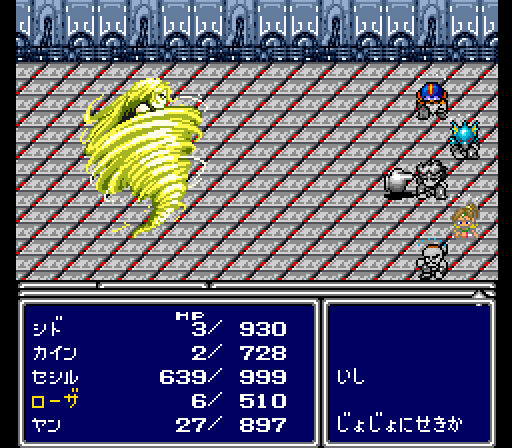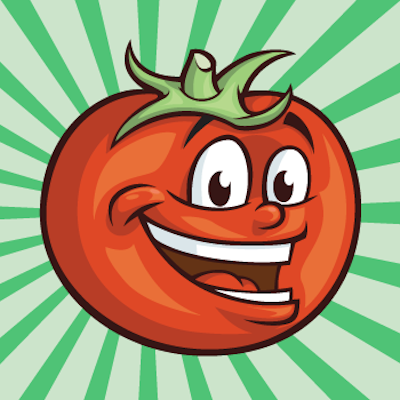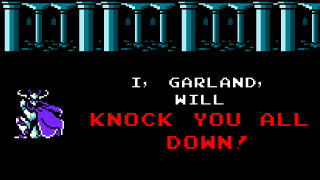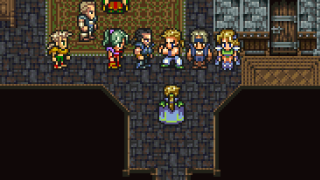A reader named Luis recently asked a question about Final Fantasy IV that I’ve often wanted to look into but just never got around to it. Until now!
I sworn I remember this weird glitch or something. During the fight with Valvalis, let her use Ray and then go to item and pick any healing item and it’ll show “D” on the stone character. Why is it called “D” and what’s the original translation in the Japanese version? I found this oddity when I was a kid and never bother to ask anyone about it on GameFAQS until I played my Final Fantasy II again.
Since it’ll be quite a while until I get to this part in the game in my Final Fantasy IV comparison, I thought I’d take a quick peek ahead and solve this mystery!
So here are some screenshots of this status effect in action:
 |  |
| Final Fantasy IV (Super Famicom) | Final Fantasy II (Super NES) |
So when you get first this slow petrification status ailment, Final Fantasy II lists the status as “D”. I never understood this, and I guess it’s been a big puzzle for lots of other fans as well. But looking at the Japanese version, the status ailment is listed as… nothing?
Yep, the “D” we all know and love is actually nothing in the original game!
If you let the status continue to worsen, eventually the English version will say “Petrify”. I thought this meant you had completely turned into stone and could no longer do anything, but it turns out that’s wrong! In the Japanese version, this status is called “Gradual petrification”. So that solves the mystery of why you can still do stuff for a little bit while in the “Petrify” state in the English release.
Lastly, once the petrification is complete, the English version calls it “Stone”. The Japanese version calls it “Stone” too.
So, basically, the gradual petrification ailment progresses like this:
Japanese: (nothing) » Gradual Petrification » Stone
English: D » Petrify » Stone
While working on the technical side of my Funky Fantasy IV project, I discovered that the character “D” and the character “T” appear in many other places in the game’s text data. In almost every instance it’s used as placeholder/filler data for lines of text that are missing or were removed from the final game. Somehow, the “D” placeholder wound up overwriting the “Gradual Petrification” text in the Super NES release. I assume the mistake is related to the removal of individual status ailment remedy items in the Super NES release.


![press start to translate [Final Fantasy IV] press start to translate [Final Fantasy IV]](https://legendsoflocalization.com/wp-content/uploads/2019/08/bbenma.png)



I guess no one wants the D then
Poor D. If only it was a 3D. Then maybe people would want it.
FF4 has a number of status effects that never show in the battle window. When they translated the game, they were all set to “D” (for dummy). In the case of this status, they obviously goofed and marked a blank, but used, string as a dummied one.
Cool find, by the way, I never even noticed the string was blank in the Japanese version. I believe the PlayStation version goes Gpetrify > Petrify > Stone, but now I want to double check.
I’m pretty sure that the status is called Gradual Petrification all the way through until actual Stone in future FF4 versions.
I guess “D” stands for Dummy. Given everything else that’s cut out of the game, it makes sense.
I still wonder why the Cockatrice summon was dummied though. Did it have to do with the five-letter limit?
I’m not sure, either someone messed up while going down a list and writing “Dummy” everywhere or maybe someone thought “Cocka” was a bad term to use for the game.
Why couldn’t they just rename it? Or call it Trice?
Maybe Trice didn’t occur to them. I’d like to find out, but I dunno who was responsible for that sort of stuff.
Sigh. As much as I love FF4, the original translation was just so bad.
(I know this is a year late)
Tossing my theory in about the “D” issue…
I was originally thinking that it might have been an issue where they replaced the Hirigana table with the English alphabet, and there was a space character in the Hirigana table where the capital letter “D” was, but having just seen your own “Name Thyself” section of the FF4 LoL page (http://legendsoflocalization.com/final-fantasy-iv/baron/#name-thyself), this isn’t the case.
I’m not familiar with how the script is stored in the ROM itself, but from my own personal experiences with HEX hacking, some scripts use a 2-Byte newline code of “0x0D0A” for a Carriage Return or Line Feed (CR/LF) followed by a null terminator (0x00) to end a string.
I also do not know if the script uses Shift-JIS or similar UTF-8/16 formatting for the character codes for the Kana, but they would also follow the 2-Byte thing. If so, then I propose that the original script used a similar thing for the blank space, but as the status’ are required to display something, the End of Line terminator code was cut short from 2-Bytes and is now 1-Byte in the English version, and effectively killed the “New Line/Blank” factor.
Then again, this is a game from the early 90’s, so I doubt they saved the scripts in an easy format. But, hey! ^_^
Maybe the D was meant to stand for “Delayed” ?